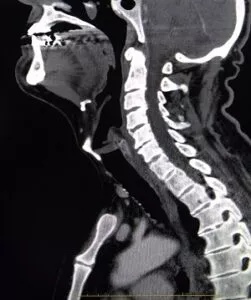
Myelogram of the Spine
A myelogram, an older test, examines the spinal canal and spinal cord. The doctor injects a special dye into the spinal sac that will indicate any abnormalities on X-rays. Before there were CT and MRI scans, the myelogram was the best test to determine the cause of pressure on the spinal cord or spinal nerves. Today the myelogram only gets used for very special purposes, such as for complicated revision spine surgeries. If you have a herniated disc, it rarely becomes the first test used.
Why is it done?
The dye used during a myelogram outlines the spinal cord and nerve roots. This helps your doctor see any unusual indentations or abnormal shapes in the spinal cord. Anything that pushes into the nerves shows up as an indentation into the spinal sac. This indentation could originate from a herniated or bulging disc, a tumor, or an injury to the spinal nerve roots. For patients who have metal plates and screws in their spine, the myelogram becomes the first choice because metal prevents MRI scans.
How to conduct a Myelogram of the spine
The doctor must perform a spinal tap to inject dye into the spinal sac. The dye mixes with the spinal fluid so that it will show up on X-rays. You will lie on a tilting table while multiple X-rays are taken to show the flow of the dye through the spine. The myelogram is usually combined with a CT scan to get a better view of the spine in cross-section and to check the health of the bones and nerves.
What are the limitations?
A myelogram does not show the soft tissues. It shows only the bones and the spinal fluid where the dye has mixed with the fluid.
What are the risks?
Because the myelogram requires a spinal tap, there are more risks associated with it than most other tests. This provides one reason that doctors prefer to use “noninvasive” tests first, such as MRI and CT scans. Although the risks associated with a spinal tap are rare, they include meningitis (infection of the spinal fluid), spinal headache, and allergic reaction to the dye. However, the needle might cause bleeding around the spinal sac. Meanwhile, the myelogram requires X-rays, which use radiation, and large doses of radiation can increase the risk of cancer. Finally, the vast majority of patients who have X-rays taken will never get enough radiation to worry about cancer. Only patients who have large numbers of X-rays — hundreds over many years need to be concerned.
If you or a loved one suffers from spinal pain, you owe it to yourself to call Southwest Scoliosis and Spine Institute at 214-556-0555 to make an appointment.


